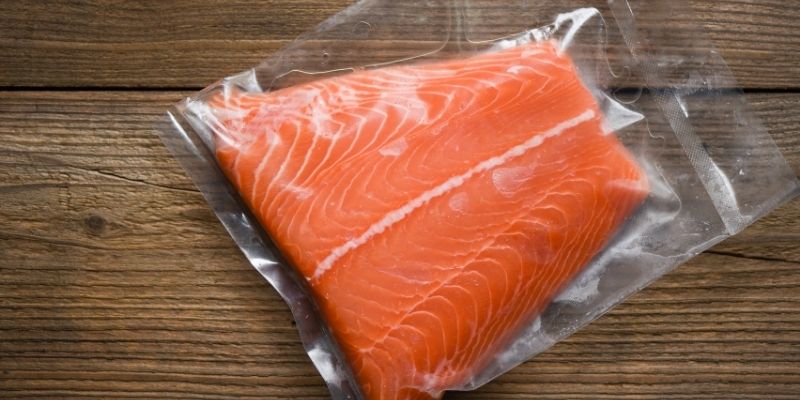Did you know that freezing fish and seafood is a great way to preserve them? Not only does freezing keep the food fresh, but it also locks in the flavor and nutrients.
In this blog post, we will discuss the best methods for freezing fish and seafood. Not only that, we will give tips on how to thaw it properly to keep all the flavor and nutrients!
Quick Content Navigation
Why Freeze Fish And Seafood?
Freezing fish is a process that can kill any bacteria that might be present in raw fish or seafood. This means it’s a great way to preserve freshness for longer periods of time.
The freezing process also prevents enzymatic change occurring within the food. This would otherwise spoil the fish very quickly.
By properly freezing your catch, you ensure that frozen fish and seafood will be tasty and safe to eat, even months after freezing!
What Types Of Seafood Can Be Frozen?
There are many types of seafood that can be frozen. The most popular choices are fish, shrimp, crab, and lobster.
However, you can also freeze oysters, clams, mussels, and scallops. Just make sure to blanch them first to kill any bacteria present on the surface of the seafood.
The 3 Methods Of Freezing Fish And Seafood
There are three main ways to freeze seafood:
- Raw
- Cooked
- Frozen in a marinade
First Method Of Freezing Fish And Seafood:
The most popular way to freeze fish is raw. Anglers are keen to keep their hard-won catch in pristine condition.
To do this:
- Start by selecting fresh, high-quality fish or seafood. Make sure there is no evidence of spoilage, and that the seafood is properly cleaned.
- If you are freezing fish and raw seafood, you may need to blanch it first. Blanching is a process where you quickly cook the seafood in boiling water for a few minutes. This will kill any bacteria that might be present on the surface.
Please note: to freeze raw fish fillets, you do not need to blanch. Just clean well and cut them into serving sized pieces. See figure below.

- Next, you will need to package the seafood properly. It’s important to use airtight packaging so that the seafood does not get freezer burn. You can use freezer bags, Ziploc bags, or plastic containers with lids. The safest method is to use either Ziploc bags or specialized bags for vacuum sealers, and a home food vacuum sealer.
- Label the package with the date and type of fish or seafood. Then, simply place it in the freezer for freezing!
Second Method Of Freezing Fish And Seafood:
The second way to easily freeze fish is to cook it beforehand.
To do this:
- Start by cooking the fish or seafood according to your desired method. You may bake, broil, fry, steam or even poach it.
- Once the seafood is cooked, let it cool down completely before freezing.
- Packaging and labeling instructions are the same as for raw seafood.
You may use a food vacuum sealer to pack it. However, vacuum-sealing cooked fish and seafood with soup can be tricky. So, here’s an article that can help you easily do that – Vacuum Sealing Liquids.
Third Method Of Freezing Fish And Seafood:
The third way to freeze seafood is by freezing it in a marinade. Not only does this give delicious, easy meals, some marinades will enhance the flavor and add nutrients.
To do this:
- Start by mixing your desired marinade ingredients together. You can use olive oil, soy sauce, vinegar, lemon juice or any other type of seasoning you like.
- Next, place the seafood in a Ziploc bag or freezer bag or airtight container and pour the marinade over. Make sure to coat all of the seafood evenly.
- Label the package with the date and type of fish or seafood. Then place it in the freezer for freezing!
Here’s a video tutorial of some tips on how to marinade fish.
How Do You Thaw Frozen Fish Or Seafood?
Frozen fish and seafood can be thawed in the refrigerator or sink of cold water. This allows the fish to thaw slowly to ensure it doesn’t fall apart before cooking.
If freezing in a marinade, make sure to place the package waterside-down to avoid a mess when thawing.
In the kitchen, one may also use running cold water to thaw frozen items in several minutes or less.
Another easy method is described below:
- Fill a pot with about two inches of cool or cold water and place over heat
- As soon the pot starts to boil, take it off the heat and place one item at a time into the pot.
- Turn over once midway through each thawing process so it is even on both sides.
Working with smaller pieces ensures you do not lose too much moisture when thawing. Loss of moisture can lead frozen fish or seafood to become dry and flavorless.
FAQs
How Long Can Fish And Seafood Be Frozen?
Seafood will stay fresh in the freezer for up to three months if processed correctly.
The packaging should have an expiration date on it to make sure you know how long it has been in the freezer. Seafood which has gone bad can be very dangerous to consume!
If you want to keep your fish and seafood even longer than this there are a couple of options. Freezing at a temperature below zero will preserve it for up to one year! Or, use a home food vacuum sealer to also keep fish and seafood safe for a year.
How To Reheat Frozen Fish Or Seafood?
You can reheat cooked seafood in a skillet on the stovetop or bake it in the oven until warmed through. This usually takes about 15 to 20 minutes for whole fish and around five for fillets.
The best way to tell if your meal is ready? Use an instant-read thermometer.
How Do I Know If My Fish Or Seafood Has Gone Bad?
If the fish or seafood smells bad, it has gone bad and should be thrown away immediately.
However, if the fish or seafood is still good, but you can’t eat it right away – don’t worry! Simply store it in the refrigerator for up to 2-3 days before cooking.
Conclusion
Freezing fish and seafood is easy and a great way to preserve their freshness and flavor for later use.
It’s also a very easy process that anyone can do at home with the right tools and methods.
By following these simple steps, you can enjoy your favorite seafood dishes for months to come!
You may increase the storage life of your frozen fish and seafood by using a specialized home food vacuum sealer. Check out this article – Vacuum Sealing Liquids [Quick & Easy With These Sealers]
If you find this article helpful, please leave us a comment below or share it with your friends.
For more freezing articles, check out the links below;


 Hi! I’m Sally-Anne!
Hi! I’m Sally-Anne!